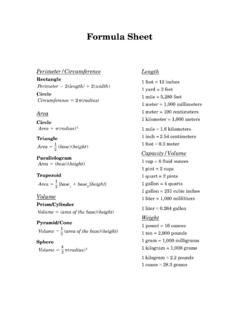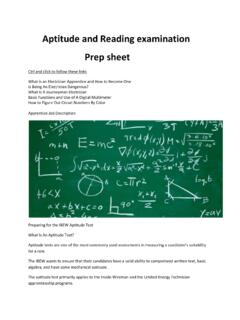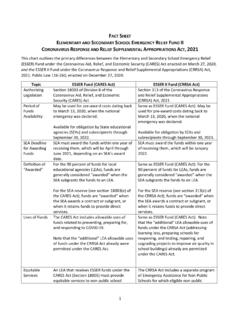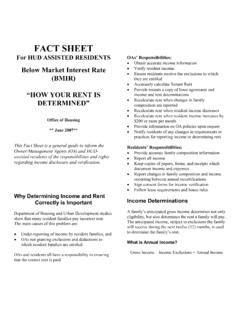Transcription of College Chemistry First Semester Review Sheet - Sault Schools
1 College Chemistry First Semester Review Sheet Fall, Dr. Wicks Chapter 1: Chemistry : The Study of Change I can explain how the subject of Chemistry fits into science and into everyday life. I can explain the scientific method to someone not enrolled in AP Chemistry . I can understand the language used in the scientific method and I can distinguish between an experiment, data, an independent variable, and a dependent variable. I can distinguish between qualitative and quantitative results. I can distinguish between and give examples of a law, a hypothesis, and a theory. I can use a classification scheme for chemical matter. I can distinguish between and give examples of homogeneous mixtures and heterogeneous mixtures. I can distinguish between and give examples of elements, compounds, atoms, and molecules.
2 I can explain the difference between chemical and physical changes and give examples of chemical and physical properties. I can distinguish between intensive and extensive properties. I can use metric-metric and english -metric conversion factors to solve problems. Tera- T trillion 1012 = 1,000,000,000,000 1 inch (in.) = cm Giga- G billion 109 = 1,000,000,000 1 pound (lb.) = 454 g Mega- M million 106 = 1,000,000 1 quart (qt.) = L Kilo- k thousand 103 = 1,000 one 100 = 1 1 mL = 1 cm3 = 1 cc Deci- d tenth 10-1 = Centi- c hundredth 10-2 = pph = parts per hundred = % Milli- m thousandth 10-3 = ppm = parts per million Micro- millionth 10-6 = ppb = parts per billion Nano- n billionth 10-9 = Pico- p trillionth 10-12 = Chemical MatterPure SubstanceElementAtomsMolecules (Atoms of sameelement)CompoundMolecules (Atoms of different elements)MixtureHomogeneous MixtureHeterogeneous MixtureCollege Chemistry First Semester Review Sheet , Page 2 I can convert between oF, oC, and K.
3 OC=59 oF 32() oF=95 oC+32 K=oC+ I can explain the difference between precision and accuracy. I can apply the rules for using significant figures in calculations. I can use dimensional analysis for problem solving. I can use densities and percents as conversion factors in problem-solving. Chapter 2: Atoms, Molecules, and Ions I can describe how Dalton s atomic theory explained the law of conservation of mass, the law of definite proportions (law of constant composition), and the law of multiple proportions. See Table 1. Table 1: Laws Explained by Dalton s Atomic Theory Law Meaning Law of Conservation of Mass Matter can be neither created nor destroyed. Law of Definite Proportions (Law of Constant Composition) Different samples of the same compound always contain its constituent elements in the same proportions by mass.
4 Law of Multiple Proportions If two elements can combine to form more than one compound, the masses of one element that combine with a fixed mass of the other element are in ratios of small whole numbers. I can explain the historical development of atomic theory and identify some of the scientists who have made important contributions. I can explain the significance of Millikan s oil drop experiment and Rutherford s gold foil experiment. I can describe the structure of the atom using protons, neutrons, and electrons. Given atomic numbers and mass numbers, I can calculate the number of protons, neutrons, and electrons in atoms of given elements. I can explain what isotopes are and how isotopic abundance can be used to calculate the atomic mass of an element. Given a periodic table of the elements, I can identify the location of groups, periods, metals, nonmetals, metalloids (semimetals), alkali metals, alkaline-earth metals, halogens, noble gases, and transition metals.
5 I can give examples of allotropes. I can use the periodic table to determine charges for ions of given elements. I know the names, chemical formulas, and charges for common polyatomic ions. H3O+ Hydronium HCO3- Hydrogen Carbonate ClO4- Perchlorate NH4+ Ammonium (also called Bicarbonate) ClO3- Chlorate OH- Hydroxide CO32- Carbonate ClO2- Chlorite C2H3O2- Acetate SO42- Sulfate ClO- Hypochlorite CN- Cyanide PO43- Phosphate MnO4- Permanganate NO3- Nitrate HPO42- Hydrogen Phosphate CrO42- Chromate NO2- Nitrite H2PO4- Dihydrogen Phosphate Cr2O72- Dichromate College Chemistry First Semester Review Sheet , Page 3 I can combine cations and anions to write formulas for ionic compounds. I can rapidly distinguish ionic compounds (metal and nonmetal elements) from molecular compounds (nonmetal elements only) for chemical nomenclature purposes.
6 I can use the following prefixes to write the names for molecular compounds. Mono- (1), di- (2), tri- (3), tetra- (4), penta- (5), hexa- (6), hepta- (7), octa- (8), nona- (9), deca- (10) I can write chemical names given chemical formulas and vice versa for ionic compounds, molecular compounds, acids, bases, and hydrates. Chapter 24: Organic Chemistry I can draw structures and name alkanes containing up to ten carbons. See Table 2. I can identify cis- and trans- isomers from the structures of simple alkenes. I can identify alkanes (CnH2n+2), alkenes (CnH2n), and alkynes (CnH2n-2) from their structures and molecular formulas. (In a later chapter, we will compare and contrast the characteristics of single, double, and triple bonds in these compounds.) Table 2: Straight Chain Alkanes Containing 1 10 Carbons Molecular formula Expanded Molecular formula Name CH4 CH4 Methane C2H6 CH3CH3 Ethane C3H8 CH2CH2CH3 Propane C4H10 CH3CH2CH2CH3 Butane C5H12 CH3CH2CH2CH2CH3 Pentane C6H14 CH3CH2CH2CH2CH2CH3 Hexane C7H16 CH3CH2CH2CH2CH2CH2CH3 Heptane C8H18 CH3CH2CH2CH2CH2CH2CH2CH3 Octane C9H20 CH3CH2CH2CH2CH2CH2CH2CH2CH3 Nonane C10H22 CH3CH2CH2CH2CH2CH2CH2CH2CH2CH3 Decane College Chemistry First Semester Review Sheet , Page 4 Chapter 3: Mass Relationships in Chemical Reactions I can calculate an element s average atomic mass from the atomic mass and natural abundance data for multiple isotopes of the same element.
7 I understand the chemical mole, and I can calculate the number of atoms or molecules present using Avogadro s number, x 1023 particles/mole. I can calculate the molar mass for a chemical formula from the atomic masses on a periodic table of the elements. I can use Avogadro s number and molar masses as conversion factors to solve problems. I can express molecular composition in terms of percent composition. Remember it is helpful to assume you have one mole of a given compound during problem solving. %CompositionofanElementinaCompound=Masso fElementMassofCompound 100() I can solve empirical formula problems using the strategy outlined in Table 3. I can use percent composition to determine the empirical formula of a compound. Remember it is helpful to assume you have 100 g of a given compound during problem solving.
8 I can use experimental data to calculate the number of water molecules in a hydrated compound. See Table 3. Table 3: Problem Solving Strategies for Empirical Formulas and Hydrate Formulas Empirical formula Calculations formula of a Hydrate Calculations 1. Get mass of each element 1. Get mass of water and anhydrous salt 2. Get moles 2. Get moles 3. Get mole ratio 3. Get mole ratio 4. Use whole number multiplier if needed 4. (Whole number multipliers are rarely needed) 5. Write the empirical formula 5. Write the formula of the hydrate I can obtain a molecular formula from an empirical formula using the molar masses of both. Recall that MMMolecularFormulaMMEmpiricalFormula =WholeNumberMultiplier needed to obtain the molecular formula .
9 I can balance simple chemical equations by inspection and complicated chemical equations by using the fraction method. I can balance chemical equations so that they have both material balance and charge balance. I can use reaction stoichiometry to interpret a chemical equation on a microscopic (molecular) level and a macroscopic (molar) level. I can calculate the mass (or moles) of one reactant or product from the mass (or moles) of another reactant or product in a balanced chemical equation. I can determine which reactant is the limiting reactant in a balanced chemical equation. I can also determine the amount of product formed and the amount of excess reactant leftover. I can distinguish between actual yield, theoretical yield, and percent yield. I can calculate theoretical yield and percent yield.
10 %Yield=ActualYieldTheoreticalYield 100() I can use stoichiometry principles to analyze a mixture or to find the empirical formula of an unknown compound. College Chemistry First Semester Review Sheet , Page 5 Chapter 4: Reactions in Aqueous Solution I can explain the difference between a strong electrolyte, a weak electrolyte, and a nonelectrolyte. I can use the solubility rules to predict the solubility of ionic compounds in water. See Table 4. I can write the ions formed when an ionic compound dissolves in water. I can predict products for precipitation reactions (double replacement reactions). I can write molecular, ionic, and net ionic equations, and I can identify spectator ions. I can recognize common acids and bases. I can explain the difference between strong and weak acids and strong and weak bases.








